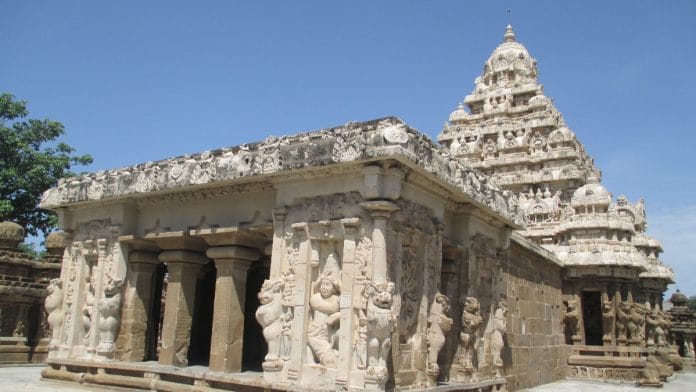New Delhi: In July 1841, when the Russian prince Alexis Soltykoff arrived in the South Indian city of Kanchipuram, he described it as resounding with the music, ritual, and vibrancy of its infinite temples. But the first recorded surveys by the Archaeological Survey of India depict these sacred sites as ruined structures in states of relative abandonment.
But today, dozens of the surveyed Pallava and Chola-period temples (circa 7th and 13th century) exist in widely ranging states of preservation, transformation, and renewal.
“Certain temples in Kanchi were selected for archaeological preservation to transform them as ‘monuments’, while others were left to experience their own cycles of life, a process that continues until today,” said Emma Natalya Stein from the Smithsonian National Museum of Asian Art during a late afternoon lecture on ‘Shared Cultural Heritage Across Indian Ocean’ at Delhi’s India International Centre on 10 February.
Stein is the author of Constructing Kanchi: City of Infinite Temples. The 2021 book explores the relationship between temples as local landscapes and trans-regional networks of religion and power.
Stein is an assistant curator of South and Southeast Asian Art at the National Museum of Asian Art, Smithsonian Institution. Her exhibitions include Revealing Krishna: Journey to Cambodia’s Sacred Mountain, Prehistoric Spirals: Earthenware from Thailand, and Power in Southeast Asia.
Also Read: Purana Qila is being dug up again. ASI wants to reach all the way to the Mahabharata era
Airavatesvara temple’s new lease on life
Kanchi is better known among art historians as home to the Kailasanathar Temple, a royal Pallava monument built by a king at the beginning of the 8th century.
Among the temples that were left to themselves through the ages was the Airavatesvara temple. Built in the eighth century under the auspices of the Pallavas, it was abandoned until very recently.
“After centuries of neglect, the temple was renovated and revitalised in 2014, entirely through local patronage. The temple is not protected by the ASI,” Stein said.
A Chennai lawyer sponsored the renovation and hired a tea seller, who runs a shop adjacent to the temple, to oversee the repair work. In the absence of conservation expertise, it was decided that dusting and light cleaning would be sufficient. And, much like the sculptures that emerged from behind the cobwebs, people began to return to the temple.
What had been abandoned and lost became a sacred space and place for a peaceful gathering again.
“Throughout the Covid pandemic, the temple rose to even greater prominence as the site for the daily provision of food for the Kanchi community,” Stein added. The practice of distributing food packets to the needy has continued.
Also Read: Polls in view, KCR launches his 2nd big temple project — ‘can allot Rs 1,000 cr’
All roads lead to temples
Back in 2013 when Stein arrived in Kanchi for field work, there was “no comprehensive list or map of the ancient sacred places,” she told ThePrint.
She developed a map over the course of her research based on the existing archival materials which were “fairly limited”, epigraphic and archaeological reports, early photography, and colonial-era travellers’ accounts.
What struck her the most was that Kanchi, despite being home to a plethora of temples, is nothing like a typical temple town.
“In a typical temple town like Tiruvannamalai, a single expansive temple complex occupies the centre of town and the residences and commercial areas cluster tightly around it,” she explained.
In such a town, the main temple can be extremely large built up over the course of a thousand years with a formulaic structure. The main shrine is at the centre surrounded by a series of concentric square enclosure walls. Often, though not always, the main shrine is the lowest part of the temple. Between the enclosure walls are subsidiary shrines, shelters for pilgrims and garden wells, and other water features.
The entrance of the complex is typically through towering gateways called gopura that are aligned with the four cardinal directions and streets lead directly to the gateways.
“This means that the gateways serve as points of orientation for any approaching visitor and the temple can be seen from anywhere in the city or the town,” Stein said. Hence, the temples and sacred places functioned as landmarks for sailors and seafaring communities.
However, Kanchi’s landscape is different.
Despite being peppered with temples, there is no one centre. “Instead of a large temple, it is the road that defines the centre of the city. It runs north-south and all the temples in the city face the road. This is one of my most exciting findings,” she said.
All temples on the west side of the road face east, and all temples on the east side of the road face west. Regardless of how many entrances they might have, their main door always faces the main road. This orientation is consistent regardless of a temple’s religious dedication, date of construction, or any other factor.
While there is no city like Kanchi in Tamil Nadu, according to Stein, there are places across the wider South Asian and Southeast Asian region that share key features with this city like Bhubaneswar (India), Polonnaruwa (Sri Lanka), Bagan (Myanmar), Angkor (Cambodia). All these cities have been royal capitals with multi-religious populations.
“However I have travelled to each of these cities to map the orientations and locations of temples and nowhere but Kanchi does this convention of orientation towards the main road hold true,” she said.
Even today, if a new temple is constructed and if it is built on the east side, it would face the west and vice versa. Nobody discusses it. It is just how it is done, she said.
(Edited by Theres Sudeep)






